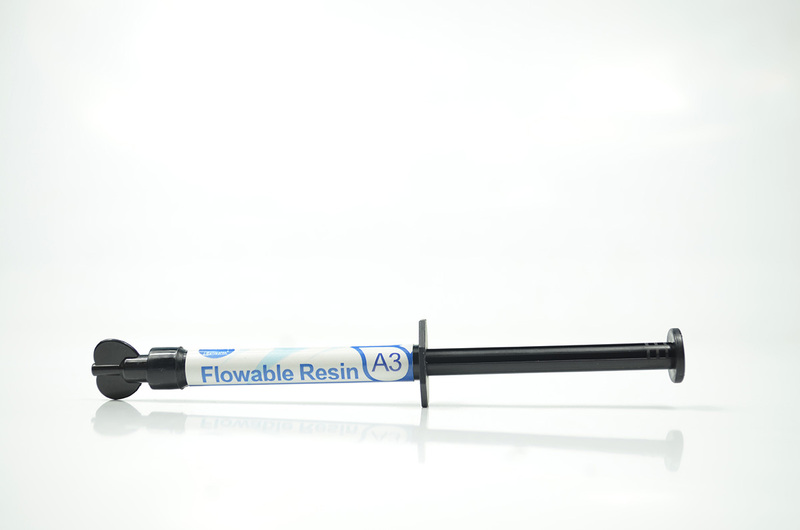Flowable Resin
Flowable Resin
Flowable Resin
- 产品详情
【Product name】Flowable Resin
【Specification】1.0g/ 1.5g/ 2.0g/ 3.0g/ syringe
【Model】 A1, A2, A3, A3.5, A4, B1, B2, C2, D2, W, XW, OA3
【Ingredients】 Flowable Resin is a light-curing resin for the adhesive filling technique. lt mainly composed of Bis-GMA, TEGDMA and Inorganic filler.
【Application】
● Direct anterior and posterior tooth restorations in Black's classes Ⅲ and V
● Indirect restorations such as inlays, onlays and veneers
● Extended fissure sealing on molars and premolars
【Applicable Scenarios】
● Preparation of the natural tooth
● Before starting the treatment, clean the hard tissue with fluoride-free polishing paste
● Choose the color using the Vita*-shade guide while the tooth is still moist.
【Certification】 ISO13485/ Free Sales Certificate
【Product properties】
● High wet ability of the tooth surface, ensuring penetration into every irregularity.
● Radio-opaqueness.
● Form minimum thickness layers to improve or eliminate air inclusion or entrapment
● High flexibility, less likely to be displaced in stress concentration areas.
● Availability in different colors.
【Storage conditions】 Store at room temperatures and avoid direct sunlight.
【Service life】Unopened for 3 years,.
【Contraindications】Contraindicated in patients with allergies to the components of this product.
【Special reminder】Only for use in dentistry, keep out of children's reach
.
【Caution】
1. The dentist should consider known interactions and cross reactions of the product with other materials already in the patient's mouth before using the product.
2. Unpolymerized resin may lead to skin allergies.
3. Phenolic substances (e.g. eugenol) inhibit polymerization, therefore these materials (e.g. zinc oxide eugenol cements) must not be used as liners.
4. Discoloration may occur upon using of chlorhexidine or oral washing liquids.
【Package】
| 1.0g/ syringe | 1 syringe x 1 bag | |
| 1.5g/ syringe | 1 syringe x 1 bag | |
| 2.0g/ syringe | 1 syringe x 1 bag | |
| 3.0/ syringe | 1 syringe x 1 bag |

Polymerization time: 20 seconds
【How to use】
1. Cavity preparation
Gently prepare the hard tissue according to the rules of the adhesive technique. When working on anterior teeth, bevel all enamel edges. Do not bevel the edges when working on posterior teeth. Avoid featheredged margins. Next, clean the cavity with water spray, remove all residues and dry. Complete drying is necessary. We recommend the use of a rubber dam.
2. Pulp protection /liner
When using an enamel-dentin adhesive, the liner can be foregone. In case of very deep cavities near the pulp, line with a calcium hydroxide compound accordingly.
3. Design of approximal contacts
In cavities with approximal sections, set in a transparent matrix and fix.
4. Etching and bonding
Apply the etching gel to the prepared surface, etch for 30 seconds on enamel or 15 seconds on dentin, then rinse off the etching gel thoroughly with water. Avoid drying the dentin. The dry, etched enamel surface will appear greyish white and must be kept free of contamination before the adhesive is applied. If the prepared area is contaminated with saliva, rinse and dry again. Etch again if necessary. Shake Bond LC well and apply the adhesive generously to the dentin and enamel surfaces with a brush, applying vigorously for approximately 30 seconds. Afterwards, blow dry carefully with oil-free compressed air for approximately 15 seconds. After curing the adhesive layer for 20 seconds using a polymerizing lamp (light-curing device), apply a second coat of adhesive in the same manner.
5. Application of the composite
This flowable resin can be dispensed directly from the applicator tip. It is recommended that both the patient and dental personnel wear protective eyewear when using the applicator tip. Preparing the Applicator Tip: a, b, c, d, e, f.
a. Remove the cap and save it.
b. Securely attach the applicator tip to the syringe-type resin.
c. Hold the applicator tip away from the patient and any dental personnel, then dispense a small amount of flowable resin to ensure the delivery system not clogging.
d. If clogged, remove the applicator tip and dispense a small amount of resin directly from the delivery tip.
e. If any visible blockage is present, clear it from the open end of the applicator tip.
f. Replace with a new applicator tip and dispense the resin again. This flowable resin can be dispensed onto a mixing pad and applied using a brush or other suitable instrument
6. Polymerization
The polymerization time is 20 sec, per layer for colors with a commercial polymerization system, an LED polymerization lamp or 2 x 3 sec, with a plasma polymerization system. Hold the light-guide as close to the surface of the filing as possible. Fillings with several surfaces should be polymerized from the direction of each surface.
7. Finishing
Nano Composite can be finished and polished immediately after polymerization. Available grinding tools include finishing diamonds, flexible split disc silicone polishers and polishing brushes. Check the occlusion and functional movement, adjust if necessary, and finally polish with a suitable polishing paste.
Special instructions
The working range under a surgical light is 2 min. In case of extensive restorations, the surgical light should be moved away from the working area temporarily to avoid premature curing of the composite. Alternatively, the material can be covered with alight-tight foil.
Use a light polymerization system with an emission range of 450 nm and intensity of 500mW/cm2 to polymerize the material. The required physical properties are only reached if the polymerization light functions properly. Therefore, it is necessary to check the light intensity regularly.
